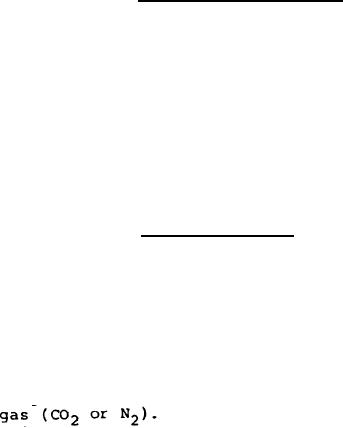 |
|||
|
|
|||
| ||||||||||
|
|  MIL-C-70501 (AR)
with methylene chloride, for a minimum of 16 hours in a Roweg
extractor (MIL-STD-286, Method 104.1.3).
Evaporate the extract
to dryness, using a current of clean, dry air. This extract is
to be used for diphenylamine determination in 4.5.1.3.2. Dry
the residues (non-extractable material) in the extraction
thimbles by aspirating the thimble and contents until the odor
of methylene chloride is not discernable.
Dry the thimble plus
residue for 1/2 hour minimum at 100 2C. Cool in a desic-
cator (1/2 hr. min.).
Determine the dry weight of this residue
(Weight C) to the nearest 0.2 mg. as the difference between
this weight and the weight of the empty thimble. This residue
is to be used for the nitrocellulose determination in 4.5.1.3.3.
4.5.1.3.2 Diphenylamine (DPA).
To the dried extract from
4.5.1.3.1 add 50 milliliters (ml.) of glacial acetic acid. If
necessary, warm slightly to dissolve the extract, then cool to
room temperature.
Complete the determination of diphenylamine
in the solution according to Method 201.1.4 (starting with
paragraph 5.5) of MIL-STD-286 except that 25 ml. of methylene
chloride is to be added after addition of the potassium iodide
solution. When the end point appears to have been reached,
(absence of blue color) the flask is stoppered and shaken. If
no color appears, the end point has been reached; otherwise,
continue titration until the blue color is discharged and shak
ing produces no further color. Calculate the percent DPA as
shown in MILSTD-286, Method 201.1.4, paragraph 5.13.
4.5.1.3.3 Nitrocellulose. To provide good heat conduction
to the solvent, place a sufficient quantity of glycerin on the
flask bottom and on the surface of the heat source to produce a
continuous film. Add 10 ml. of ethyl alcohol to the thimble
and residue from 4.5.1.3.1 and extract with acetone using the
method in 4.5.1.3.1. After extraction dry the residue remain-
ing at 100 2C for one hour.
Cool in a desiccator (1/2 hr.
rein), weight to the nearest 0.2 mg. (Weight D) and save for the
acrylic determination in 4.5.1.3.4.
Evaporate the acetone
extract to dryness and add 25 ml. of n-butyl acetate and 45 ml
of glacial acetic acid. Replace the air with a stream of inert
Maintain the inert atmosphere throughout
Reflux the solution for five minutes. Add to the
this test.
flask, via the condenser, 25 ml of 0.7N ferrous ammonium
sulfate (prepared per MIL-STD-286, Method 604.1.1) and 10 ml.
concentrated hydrochloric acid.
Reflux for thirty minutes more
to obtain a yellow liquid in which the specimen is completely
disintegrated.
With the inert gas still running, cool in a
water bath to room temperature. Add 5 ml. of 20% ammonium
thiocyanate solution (MIL-STD286, Method 706.1). Titrate with
16
|
|
Privacy Statement - Press Release - Copyright Information. - Contact Us |